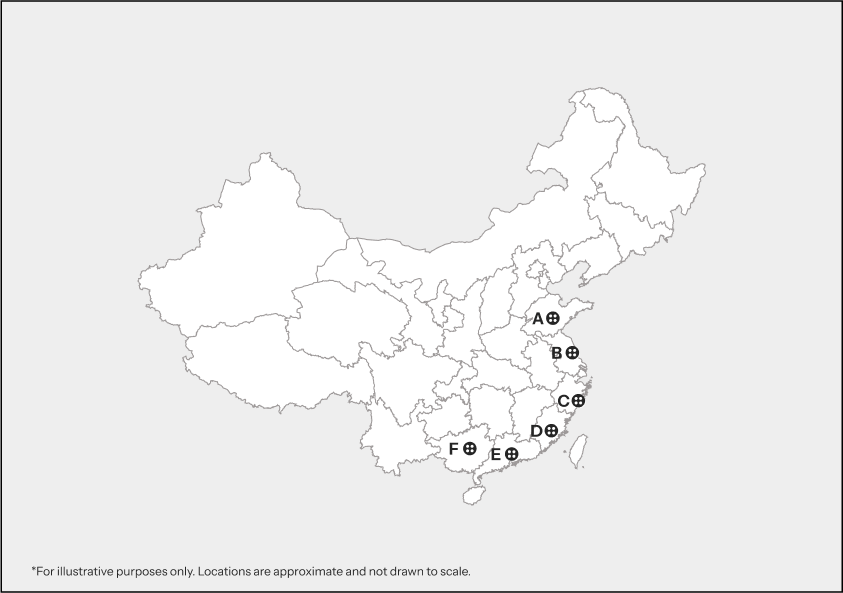China
download summary
Country Overview
No items found.
No items found.
*All data is in tonnes per annum
TEXTILE WASTE*
Post consumer textile waste
No items found.
pre consumer textile waste
Post Industrial textile waste
No items found.
Imported textile waste
No items found.
KEY POINTS ON Textiles & Apparels LANDSCAPE
$296B
T&A Exports (2024)
70%–80%
Clothing Produced in China was Consumed Domestically (2013 - 2022)
Attributing to its large economies of scale and strong government support, China contributes 35% of global textiles and 30% of global apparel production. Within China’s textile and apparel (T&A) exports, apparel accounts for the largest share, with major international brands such as Nike, Adidas, Uniqlo, Puma, and Gap sourcing from the country. Despite being the world’s largest exporter, the majority of China’s production is consumed domestically. The Chinese government continues to play a pivotal role in fostering innovation, driving investments and incentives in key focus areas.
6.2 MT
Cotton Production
China is the world’s largest producer and consumer of natural and MMF and yarns, with Xinjiang supplying 80% of its cotton output. It contributes over 70% of global polyester fibre with Zhejiang and Fujian leading MMF yarn production. Investment is also growing in high-performance and bio-based fibres.
>70%
Large-scale facilities have Introduced Automated Cutting Systems and in some case Automated Sewing
China integrates the full supply chain from fibre to finished products. Private enterprises dominate downstream production (garments), while state-owned enterprises lead in capital-intensive segments (e.g., fibre, industrial textiles). Chinese manufacturers are also expanding their operations in other countries in Asia, Africa and EU.
70%
Domestic Clothing Sales account from Synthetics
China generates a huge volume of textile waste, with 76% landfilled/incinerated. Under its phased targets, the recycling rate is expected to rise to 30% by 2030. Between 2019- 2023, recycled textile volumes grew faster than overall waste generation, indicating a positive shift towards national recycling goals. However, the recycling industry remains highly fragmented and dominated by SMEs. Current recyclers are largely dependent on post-industrial waste, which is abundantly available. For post-consumer waste, the sector primarily relies on brand-led takeback programs, but sorting and pre-processing automation remains limited.
production clusters
Key regions with fibre production
Xinjiang(A), Zhejiang(B), Jiangsu(C), Shandong(D), Fujian(E)

Key regions with apparel production
Shandong (A), Jiangsu (B), Zhejiang (C), Fujian (D), Guangdong (E), Guangxi (F)

- Major players in apparel manufacturing include Hongyu Apparel, Crystal International Grp Ltd , TAL Apparel and fibre manufacturers like -Tongkun Group, Jiangsu Guotai International Group and Zhejiang Hengyi Group
- China's exports of upstream materials like yarn and fabric to manufacturing countries such as Vietnam and Bangladesh have increased.
- Growing adoption of sustainability certifications in response to growing international buyers' requirements and consumers' demand for eco-friendly products. Alongside international standards like OEKO-TEX, local certification like CNTAC Green Factory Certification and China Environmental Labeling which are also driving industries towards more sustainable practices.
Waste regulation
NDRC has created the IOARWT document that outlines a national plan to build a robust textile waste recycling system by 2030. It set targets to recycle 25% of textile waste, achieving an output of 2 million tons of recycled fibres, and to increase this to 30% with 3 million tons of recycled fibre annually by 2030. The policy focuses on improving the recycling network, broadening recycling channels, strengthening recycling management, and raising awareness of textile recycling among producers and consumers
It explicitly integrates textile waste into the national recycling strategy. Its key goals are to establish efficient collection and sorting systems, build advanced recycling facilities, and promote the reuse of textiles and recycled fibers in new industries. It also launches pilot programs in cities to test innovative management models. This plan lays the foundation for achieving a national target of recycling 3 million tons of waste textiles by 2025.
"Internet + recycling” in China leverages online platforms, IoT, and big data to connect consumers with efficient, transparent recycling services and was advanced nationally under the “14th Five-Year Plan for Circular Economy Development” of July 2021. It provides digital solutions for fragmented waste collection, material traceability, and low recycling rates. Feimayi is a leading platform enabling online scheduling, door-to-door collection, and large-scale participation in second-hand clothing recycling.
Waste trade
Not available
Import quantities (HS 6309, 631010)
1180.11 kT
Export quantities (HS 6309, 631010)
green energy
11.72%
Share of modern renewables in final energy consumption
- Renewable Electricity Generation by source: Hydro (46.6%), Wind (32%), Solar PV (21%)
- In 2024, China accounted for over 40% of global renewable energy capacity and invested an astounding $818 billion in its energy transition, more than double the investment of any other economy. Following a “build first, break later” strategy, it rapidly scales renewables, hydropower, and nuclear while modernizing its grid. This makes the global green transition more cost-effective in China.
- The People’s Bank of China launched the Carbon Emission Reduction Facility (CERF) in November 2021 to support low-cost financing for green projects. PBoC covers 60% of loans at 1.75% interest, with banks lending at competitive rates to enterprises that demonstrate measurable carbon reduction, verified through a self-reporting and third-party system.
- From January 1, 2025, to December 31, 2028, China has introduced a 10% tax credit on reinvested profits in qualifying sectors, including advanced manufacturing in the renewable energy transition. Investors must commit to a minimum holding period of five years for the reinvested assets.

